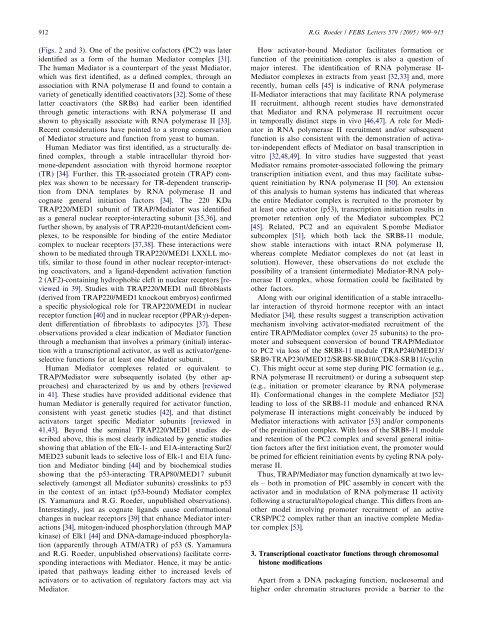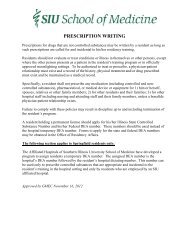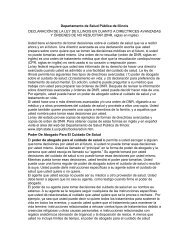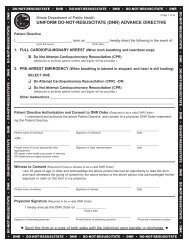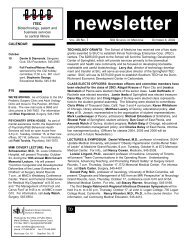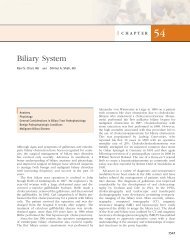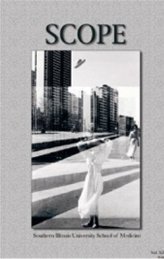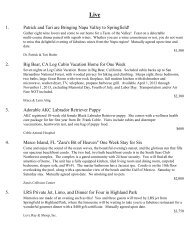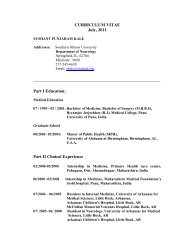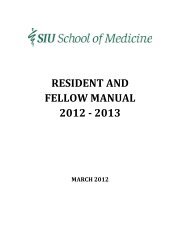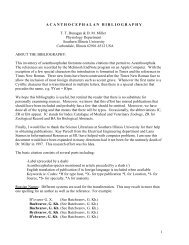Transcriptional regulation and the role of diverse coactivators in animal cells
Transcriptional regulation and the role of diverse coactivators in animal cells
Transcriptional regulation and the role of diverse coactivators in animal cells
You also want an ePaper? Increase the reach of your titles
YUMPU automatically turns print PDFs into web optimized ePapers that Google loves.
912 R.G. Roeder / FEBS Letters 579 (2005) 909–915<br />
(Figs. 2 <strong>and</strong> 3). One <strong>of</strong> <strong>the</strong> positive c<strong>of</strong>actors (PC2) was later<br />
identified as a form <strong>of</strong> <strong>the</strong> human Mediator complex [31].<br />
The human Mediator is a counterpart <strong>of</strong> <strong>the</strong> yeast Mediator,<br />
which was first identified, as a def<strong>in</strong>ed complex, through an<br />
association with RNA polymerase II <strong>and</strong> found to conta<strong>in</strong> a<br />
variety <strong>of</strong> genetically identified <strong>coactivators</strong> [32]. Some <strong>of</strong> <strong>the</strong>se<br />
latter <strong>coactivators</strong> (<strong>the</strong> SRBs) had earlier been identified<br />
through genetic <strong>in</strong>teractions with RNA polymerase II <strong>and</strong><br />
shown to physically associate with RNA polymerase II [33].<br />
Recent considerations have po<strong>in</strong>ted to a strong conservation<br />
<strong>of</strong> Mediator structure <strong>and</strong> function from yeast to human.<br />
Human Mediator was first identified, as a structurally def<strong>in</strong>ed<br />
complex, through a stable <strong>in</strong>tracellular thyroid hormone-dependent<br />
association with thyroid hormone receptor<br />
(TR) [34]. Fur<strong>the</strong>r, this TR-associated prote<strong>in</strong> (TRAP) complex<br />
was shown to be necessary for TR-dependent transcription<br />
from DNA templates by RNA polymerase II <strong>and</strong><br />
cognate general <strong>in</strong>itiation factors [34]. The 220 KDa<br />
TRAP220/MED1 subunit <strong>of</strong> TRAP/Mediator was identified<br />
as a general nuclear receptor-<strong>in</strong>teract<strong>in</strong>g subunit [35,36], <strong>and</strong><br />
fur<strong>the</strong>r shown, by analysis <strong>of</strong> TRAP220-mutant/deficient complexes,<br />
to be responsible for b<strong>in</strong>d<strong>in</strong>g <strong>of</strong> <strong>the</strong> entire Mediator<br />
complex to nuclear receptors [37,38]. These <strong>in</strong>teractions were<br />
shown to be mediated through TRAP220/MED1 LXXLL motifs,<br />
similar to those found <strong>in</strong> o<strong>the</strong>r nuclear receptor-<strong>in</strong>teract<strong>in</strong>g<br />
<strong>coactivators</strong>, <strong>and</strong> a lig<strong>and</strong>-dependent activation function<br />
2 (AF2)-conta<strong>in</strong><strong>in</strong>g hydrophobic cleft <strong>in</strong> nuclear receptors [reviewed<br />
<strong>in</strong> 39]. Studies with TRAP220/MED1 null fibroblasts<br />
(derived from TRAP220/MED1 knockout embryos) confirmed<br />
a specific physiological <strong>role</strong> for TRAP220/MED1 <strong>in</strong> nuclear<br />
receptor function [40] <strong>and</strong> <strong>in</strong> nuclear receptor (PPARc)-dependent<br />
differentiation <strong>of</strong> fibroblasts to adipocytes [37]. These<br />
observations provided a clear <strong>in</strong>dication <strong>of</strong> Mediator function<br />
through a mechanism that <strong>in</strong>volves a primary (<strong>in</strong>itial) <strong>in</strong>teraction<br />
with a transcriptional activator, as well as activator/geneselective<br />
functions for at least one Mediator subunit.<br />
Human Mediator complexes related or equivalent to<br />
TRAP/Mediator were subsequently isolated (by o<strong>the</strong>r approaches)<br />
<strong>and</strong> characterized by us <strong>and</strong> by o<strong>the</strong>rs [reviewed<br />
<strong>in</strong> 41]. These studies have provided additional evidence that<br />
human Mediator is generally required for activator function,<br />
consistent with yeast genetic studies [42], <strong>and</strong> that dist<strong>in</strong>ct<br />
activators target specific Mediator subunits [reviewed <strong>in</strong><br />
41,43]. Beyond <strong>the</strong> sem<strong>in</strong>al TRAP220/MED1 studies described<br />
above, this is most clearly <strong>in</strong>dicated by genetic studies<br />
show<strong>in</strong>g that ablation <strong>of</strong> <strong>the</strong> Elk-1- <strong>and</strong> E1A-<strong>in</strong>teract<strong>in</strong>g Sur2/<br />
MED23 subunit leads to selective loss <strong>of</strong> Elk-1 <strong>and</strong> E1A function<br />
<strong>and</strong> Mediator b<strong>in</strong>d<strong>in</strong>g [44] <strong>and</strong> by biochemical studies<br />
show<strong>in</strong>g that <strong>the</strong> p53-<strong>in</strong>teract<strong>in</strong>g TRAP80/MED17 subunit<br />
selectively (amongst all Mediator subunits) crossl<strong>in</strong>ks to p53<br />
<strong>in</strong> <strong>the</strong> context <strong>of</strong> an <strong>in</strong>tact (p53-bound) Mediator complex<br />
(S. Yamamura <strong>and</strong> R.G. Roeder, unpublished observations).<br />
Interest<strong>in</strong>gly, just as cognate lig<strong>and</strong>s cause conformational<br />
changes <strong>in</strong> nuclear receptors [39] that enhance Mediator <strong>in</strong>teractions<br />
[34], mitogen-<strong>in</strong>duced phosphorylation (through MAP<br />
k<strong>in</strong>ase) <strong>of</strong> Elk1 [44] <strong>and</strong> DNA-damage-<strong>in</strong>duced phosphorylation<br />
(apparently through ATM/ATR) <strong>of</strong> p53 (S. Yamamura<br />
<strong>and</strong> R.G. Roeder, unpublished observations) facilitate correspond<strong>in</strong>g<br />
<strong>in</strong>teractions with Mediator. Hence, it may be anticipated<br />
that pathways lead<strong>in</strong>g ei<strong>the</strong>r to <strong>in</strong>creased levels <strong>of</strong><br />
activators or to activation <strong>of</strong> regulatory factors may act via<br />
Mediator.<br />
How activator-bound Mediator facilitates formation or<br />
function <strong>of</strong> <strong>the</strong> pre<strong>in</strong>itiation complex is also a question <strong>of</strong><br />
major <strong>in</strong>terest. The identification <strong>of</strong> RNA polymerase II-<br />
Mediator complexes <strong>in</strong> extracts from yeast [32,33] <strong>and</strong>, more<br />
recently, human <strong>cells</strong> [45] is <strong>in</strong>dicative <strong>of</strong> RNA polymerase<br />
II-Mediator <strong>in</strong>teractions that may facilitate RNA polymerase<br />
II recruitment, although recent studies have demonstrated<br />
that Mediator <strong>and</strong> RNA polymerase II recruitment occur<br />
<strong>in</strong> temporally dist<strong>in</strong>ct steps <strong>in</strong> vivo [46,47]. A <strong>role</strong> for Mediator<br />
<strong>in</strong> RNA polymerase II recruitment <strong>and</strong>/or subsequent<br />
function is also consistent with <strong>the</strong> demonstration <strong>of</strong> activator-<strong>in</strong>dependent<br />
effects <strong>of</strong> Mediator on basal transcription <strong>in</strong><br />
vitro [32,48,49]. In vitro studies have suggested that yeast<br />
Mediator rema<strong>in</strong>s promoter-associated follow<strong>in</strong>g <strong>the</strong> primary<br />
transcription <strong>in</strong>itiation event, <strong>and</strong> thus may facilitate subsequent<br />
re<strong>in</strong>itiation by RNA polymerase II [50]. An extension<br />
<strong>of</strong> this analysis to human systems has <strong>in</strong>dicated that whereas<br />
<strong>the</strong> entire Mediator complex is recruited to <strong>the</strong> promoter by<br />
at least one activator (p53), transcription <strong>in</strong>itiation results <strong>in</strong><br />
promoter retention only <strong>of</strong> <strong>the</strong> Mediator subcomplex PC2<br />
[45]. Related, PC2 <strong>and</strong> an equivalent S.pombe Mediator<br />
subcomplex [51], which both lack <strong>the</strong> SRB8-11 module,<br />
show stable <strong>in</strong>teractions with <strong>in</strong>tact RNA polymerase II,<br />
whereas complete Mediator complexes do not (at least <strong>in</strong><br />
solution). However, <strong>the</strong>se observations do not exclude <strong>the</strong><br />
possibility <strong>of</strong> a transient (<strong>in</strong>termediate) Mediator-RNA polymerase<br />
II complex, whose formation could be facilitated by<br />
o<strong>the</strong>r factors.<br />
Along with our orig<strong>in</strong>al identification <strong>of</strong> a stable <strong>in</strong>tracellular<br />
<strong>in</strong>teraction <strong>of</strong> thyroid hormone receptor with an <strong>in</strong>tact<br />
Mediator [34], <strong>the</strong>se results suggest a transcription activation<br />
mechanism <strong>in</strong>volv<strong>in</strong>g activator-mediated recruitment <strong>of</strong> <strong>the</strong><br />
entire TRAP/Mediator complex (over 25 subunits) to <strong>the</strong> promoter<br />
<strong>and</strong> subsequent conversion <strong>of</strong> bound TRAP/Mediator<br />
to PC2 via loss <strong>of</strong> <strong>the</strong> SRB8-11 module (TRAP240/MED13/<br />
SRB9-TRAP230/MED12/SRB8-SRB10/CDK8-SRB11/cycl<strong>in</strong><br />
C). This might occur at some step dur<strong>in</strong>g PIC formation (e.g.,<br />
RNA polymerase II recruitment) or dur<strong>in</strong>g a subsequent step<br />
(e.g., <strong>in</strong>itiation or promoter clearance by RNA polymerase<br />
II). Conformational changes <strong>in</strong> <strong>the</strong> complete Mediator [52]<br />
lead<strong>in</strong>g to loss <strong>of</strong> <strong>the</strong> SRB8-11 module <strong>and</strong> enhanced RNA<br />
polymerase II <strong>in</strong>teractions might conceivably be <strong>in</strong>duced by<br />
Mediator <strong>in</strong>teractions with activator [53] <strong>and</strong>/or components<br />
<strong>of</strong> <strong>the</strong> pre<strong>in</strong>itiation complex. With loss <strong>of</strong> <strong>the</strong> SRB8-11 module<br />
<strong>and</strong> retention <strong>of</strong> <strong>the</strong> PC2 complex <strong>and</strong> several general <strong>in</strong>itiation<br />
factors after <strong>the</strong> first <strong>in</strong>itiation event, <strong>the</strong> promoter would<br />
be primed for efficient re<strong>in</strong>itiation events by cycl<strong>in</strong>g RNA polymerase<br />
II.<br />
Thus, TRAP/Mediator may function dynamically at two levels<br />
– both <strong>in</strong> promotion <strong>of</strong> PIC assembly <strong>in</strong> concert with <strong>the</strong><br />
activator <strong>and</strong> <strong>in</strong> modulation <strong>of</strong> RNA polymerase II activity<br />
follow<strong>in</strong>g a structural/topological change. This differs from ano<strong>the</strong>r<br />
model <strong>in</strong>volv<strong>in</strong>g promoter recruitment <strong>of</strong> an active<br />
CRSP/PC2 complex ra<strong>the</strong>r than an <strong>in</strong>active complete Mediator<br />
complex [53].<br />
3. <strong>Transcriptional</strong> coactivator functions through chromosomal<br />
histone modifications<br />
Apart from a DNA packag<strong>in</strong>g function, nucleosomal <strong>and</strong><br />
higher order chromat<strong>in</strong> structures provide a barrier to <strong>the</strong>


